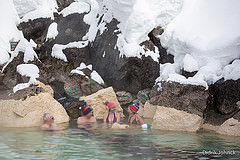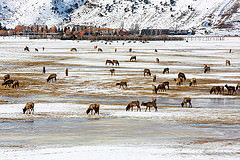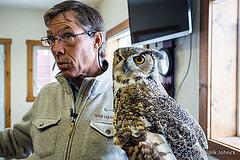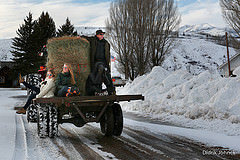Lisa Niver's Blog: We Said Go Travel, page 378
July 22, 2014
Nigeria: A Surreal Africa
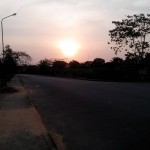
I could not believe my eyes. There i was, amongst dignitaries from all works of life.
I must have been the youngest in the bus. I was not sure how how i found myself there, but i knew that was where i belonged.
Omotola Jalade had sat behind me, and Chimamanda Adichie, in front of me.
I sat in awe, gazing at the sun set from behind an acacia tree.
It seemed surreal, because i had only seen sun sets and acacia trees in pictures and movies. Never had i thought that i would gaze upon such a scenery in real life.
Africa was beautiful that evening, the skys reflected shades of orange, pink and gold.
Throughout the whole tour, i knew that my spirit had been set free. It was no longer with me in the bus, but was soaring.
Trees lined up the streets of Enugu as our bus drove past them. The beautiful black children of the streets ran after our bus, excitedly screaming ‘Oyinbo people,’ which means ‘white people,’ in the Igbo language. They children had mistaken us for Americans, probably because our complexions were light, but we were all Africans. The voices of the children made my heart tingle with an unexplainable excitement.
I saw the little girls, playing the game of ‘ten-ten,’ in which they moved their feet in different directions until one of the players could predict the next direction of the others feet. The young women strapped their Children to their backs with pieces of lappas.
Soon, the driver branched into another street with potholes all over. It was a bumpy ride, but i couldn’t feel it. My mind was caught up in a group of youngsters, singing and dancing to their own beats.
My body was eager to jump out of the bus to join in their gyration. I wish i had done that.
They all seemed so happy, so nonchalant about life. Even when the bus had driven past them, i looked back with keen interest. Soon, i found myself humming the same tune i had heard them sing. It was incredible how i remembered the lyrics, which went thus:
Anyi nwe freedom!
Freedom bu nke anyi,
Anyi ga agbara egwu!
Anyi ga agbara egwu!
Maka freedom bu nke mua!
It means ‘we have freedom, freedom is ours, we will dance because freedom is ours.
The song made me feel free. Soon others in the bus joined in. It was as though the spirit of freedom was encompassing the bus eas each one joined in the singing
That was a tour i would never forget in Nigeria. It madr an imprint in my heart.
The beauty of Africa.
Thank you for reading and commenting. Please enter the Independence Travel Writing competition and tell your story.
The post Nigeria: A Surreal Africa appeared first on We Said Go Travel.
Silence of the Rivers, Allahabad, India
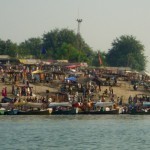
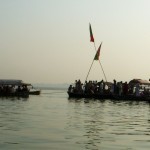
Silence of the Rivers……Allahabad
The cool trickling sand between my toes, the muddy Ganges tentative steps towards the twirling frisky Yamuna, the orange-robed Sun take its evening dip in the serene, muddy waters of the Ganges, to disappear into the horizon. Scenes photocopied over time as I stood ankle deep at the confluence of the three holy rivers of India, the Ganges, Yamuna and the mythical Saraswati.
I was born and brought up in Allahabad and the rivers were part of growing up. School vacations meant early morning drives to the banks of the Yamuna River guarded by the fort, built by Mughal Emperor Akbar, and a flotilla of boats and their owners. We had a personal boat, hired on monthly basis, one that had a cover as there were no changing rooms. It was an al- fresco experience of stripping of wet clothes for dry ones. The boat was cocooned with sheets all around and the women would self consciously shed of wet clothes. The men had no such inhibitions and would change alongside the boat.
Occasionally friends joined us for early morning swims that ended in dunking and dipping in the waters that were clearer and cleaner (1960s) than what it is today. With passing years the early morning dips gave way to solitary visits, especially in the evenings, when the only ‘noise’ for miles were the temple bells and the swish of oars of returning boatmen. It was difficult to visualize the unruffled, irenic Ganges as the same carefree stream gurgling down the snow capped Himalayas, oblivious to the tribulations ahead changing contour on its journey through mountains and plains, cities, towns and villages collecting their garbage, joys and sorrows before meeting with the Yamuna and the mythical Saraswati at Allahabad or ancient Prayag. One wonders what notes the rivers must be exchanging before collectively surging through Varanasi and finally emptying in the Bay of Bengal.
Once in twelve (12) years the rivers play host to the great bathing festival or the Kumbh Mela. Along with Allahabad, the other cities are Hardwar, Ujjain and Nasik. The story goes that the gods and the devils had fought over the urn of nectar churned from the earth and to prevent the Devils from drinking the immortal nectar, Indra, the God of Rain and Thunder, had decamped with the urn and in process four drops of nectar spilled on these four places purifying the waters and the cities. I remember accompanying my parents for one Kumbh Mela (fair) attracted more by the trinkets and street food than by religious sentiments.
I got married and moved on living in other cities and countries losing touch with my inner self till I visited my hometown, after a gap of twenty years, for the 2013 Kumbh Mela. It was as if entire humanity had congregated on the slice of the meeting point of the rivers where the young, old, rich, poor, disabled and healthy queued for that one dunk or moksha (freedom) in the waters.
Amidst all the mayhem the rivers flowed unruffled and serene oblivious to trampling feet and noisy ablutions. I stayed on till evening when the pilgrims and tourists were confined in their tents and the Sun make the most of having the waters to itself.
I turned back fortified for more life journeys.
Thank you for reading and commenting. Please enter the Independence Travel Writing competition and tell your story.
The post Silence of the Rivers, Allahabad, India appeared first on We Said Go Travel.
July 21, 2014
The Fabled Montropolis Is Found: Jackson Hole
In the evolution of a place there is sometimes a waymark between free-spirited childhood and the discreet somberness of maturity. But what if the in-between actually signifies the third point of a classic Hegelian dialectical triangle? A rough and rowdy cowboy town at one point, an overly-wrought sophisticated metropolis at the other, and the third being some subtly unstated “third way” that draws on the contradictory nature of the first two states to create a superior third? Jackson Hole may be that mythical intersection, deftly incorporating elements of the small town with the big city, a realization of humanity’s most advanced thought: the idea that recognizes its good self in all things.
The first ski lift in Jackson Hole opened in 1964, with two double chairlifts. Prior to that, winter was known as “Cocktail Hour in Jackson Hole,” as the only thing to do was drink.
When I first arrived in 1980 it was like an exotic movie set, hard to get to, as picturesque as a jigsaw puzzle. I was enlisted to be Robert Duvall’s stunt double for the film Pursuit of D.B. Cooper. The conceit: D.B. Cooper (played by Treat Williams) has parachuted into the mountains with his loot, and escapes down a wild river on a raft, with Duvall’s character in hot pursuit, plunging down huge rapids and over sheer waterfalls. I picked up my share of bruises and scratches, but the only one that remained was the itch to return to Jackson Hole.
And I did…over and over. Once to take Glenn Campbell, Tanya Tucker and Barbi Benton rafting for an ABC show. A couple of times to hike and fish (there are more miles of Wild & Scenic waters here than any other county in the country). And most recently for a wedding. But always in summer.
Now, at last, I make a winter ramble to Jackson Hole, and fall into a magic casket of promises, an invisible vibrating wall between the feather-bed of civilization and the hyperterra of a tectonic seam.
I take a non-stop from Los Angeles (there are now 12 non-stops, from as far away as New York), and make the short drive into the nave of the valley, between a title wave of stone, through town and then up to Spring Creek Ranch, which offers up accommodations with windows the size of Wales, overlooking the white flames of the Tetons and vistas that showcase seemingly boundless wilderness. Only 3% of the land is privately owned here.
So, what is this place?
In 2011 John Kasarda published a book, Aerotropolis: The Way We’ll Live Next, describing a new urban form placing airports in the center with cities growing around them. I’ve been to many of these airport cities, and found them soulless, clone-like, thick with franchises and the commerce of expediency.
Jackson Hole has an airport, the only one in America in a National Park, but there is nothing Xeroxed about it. The largest elk migration in the world is just outside the door. Try to find that anywhere else.
After traveling to metropolises and micropolises (populations between 10,000 and 50,000) around the world, this place seems different, something evolved to a higher plane, but what?
I scratch about and come up with what I think a suitable descriptor: a montropolis….a mountain town that offers up not just the riot of the natural world, and the cosmopolitan rewards of a first-class city, but then goes beyond. The components: 1) a rich art culture 2) luxury and elegance, but of a rustic flavor 3) an abundance of wildlife 4) family friendliness 5) A strong conservation ethos and 6) a range of snow and ice adventures. These six ingredients, mixed generously together, concoct Jackson Hole, perhaps the first montropolis.
After settling in, I decide to test my notion, and head to town to check out the art scene. Jackson Hole has a bewilderingly disproportionate number of artists and galleries: over 50 art galleries in a township of less than 10,000, and you can practically throw a snowball in any direction and hit an artist.
I begin with a stop at the Trio Gallery on North Cache Street, where I meet up with Kathryn Turner, a pedigree painter born and raised on a dude ranch in Grand Teton National Park. We sit in front of two towering, silvery canvases of aspens, so uncluttered they speak of Kathryn’s “beautiful destructionism,” wherein the results are so striking because she purposely leaves things out.
She says the hyper-dramatic landscapes of Jackson Hole inspire art….it’s everywhere one looks, ever changing, and the natural desire is to try to capture, or render, or express. “Jackson Hole is a place of intensity. The mountains are intense; the climate is intense…and that intensity pushes art.
“What is sublime about the landscape is that it gives us a sense of wonder. It’s bigger than we are, which transcends into the spiritual. The mountains are imprinted in my soul. Painting is my map of discovery. I will commit my entire life to trying to capture the essence of the Tetons….and it will take a lifetime.” Artist Kathyrn Turner
To demonstrate Kathryn offers an alla prima, a “quick draw,” on the spot. She adjusts her easel, dips a brush into her soul, and beings her silent poetry. Minutes later, like morning fog lifting over the Snake River, there appears the lovely portrait of a horse from her ranch.
Next I head north a couple miles to the National Museum of Wildlife Art, which sprawls like a Scottish castle on a bluff overlooking the “Museum on the Hoof,” the National Elk Refuge. Inside I meet President Jim McNutt, polite as a wine steward, who offers a little turn through the 51,000-square-foot shrine.
We stroll by an illustration of a bison herd thundering across the prairie, a sculpture of a grizzly reclining, and Andy Warhol’s 1983 vivid screen prints of endangered species from around the globe, just some of the more than 5,000 cataloged drawings, paintings, sculptures and sketches in the nation’s premier public collection of artwork devoted to wild animals. We pass an ark of styles, Romanticism, Realism, Impressionism, Modernism, and my favorite, explorer art. We admire oil, bronze, stone, acrylic, watercolor, gouache, pastel, pencil, lithography, photography, charcoal, and real flesh.
Outside stands a life-size sculpture of elk crossing a rock. This is where the real and the unreal blur, as just beyond thousands of live elk are drifting by in their natural winter setting.
Every moment is a monument at my next stop, the hub of creativity known as the Center for the Arts, an expansive pavilion that hosts a 500-seat theater, art and dance studios, and classrooms. My friend Lisa Sanford (we produced a film on orangutans in Sumatra many years ago) is the Executive Director of the Jackson Hole Wildlife Film Festival, and her offices are here. But I knock on her door, and she’s not around. I’m not surprised. It’s gorgeous outside, full of stolen light, and not many folks in Jackson stay within on a super ski day.
Instead, I meet Ponteir Sackrey, the Center Fund President, who gives a brief tour, and explains something called The Creative Vitality Index, which measures the health of the creative economy in a community. Not surprisingly, Jackson is near the top of the list.
That evening the sky glows like a bottle of cognac held up to the light. I decide to explore some of the rustic-style elegance that is requisite in the model of montropolis. When I first came to Jackson I crashed on a guide’s log cabin couch, which was about as luxurious as you might get. But today there is a plethora of luxury hotels, from the Four Seasons Resort in Teton Village to the Wort Hotel downtown to the Amangani, The Rusty Parrot, the Hotel Terra, and of course the soigné Spring Creek Ranch, where I’m staying. I have a cocktail with Steve Price, the general manager, at the Granary, the bar where the peaks outside the glass are skywriting. “These are the first mountains that look like mountains should,” Teddy Roosevelt supposedly said when first gazing at the sonic architecture. Before him it was a set of 18th century French-Canadian fur trappers, long on the road and womanless, who named the soaring mountains after female breasts: Tetons.
“I don’t think anyone in America didn’t want to grow up to be a cowboy or cowgirl.”
Steve posits with a smile wide as a hammock. “And here you can become that dream, while still steeped in the finer things in life.”Rustic elegance here means you can kick up your boots like a cowboy, revel in the romance of the American West, wrap in the authenticity, but still enjoy the finest wines, food and comfort to be found anywhere.”
Afterwards, I take a stroll through the town square to check out the shopping. High-end offerings such as Rodeo, 22 Home, Belle Cose, Wool and Whiskey, and CocoLove, a world-class chocolatier, now inhabit this town, and give it a Beverly Hills-with-altitude feeling. Oh look…Harrison Ford just came out of that shop.
For dinner I meet up with Gavin Fine at Il Villagio Osteri, a seriously good Italian restaurant, and part of his Fine Dining Restaurant Group, which includes Rendezvous Bistro, Q Roadhouse, The Kitchen, and Bin 22. Gavin’s story is not dissimilar to so many who live here. He came out years ago from restaurant-rich Chicago for a weekend of skiing and never went back. He’d been working at for Lettuce Entertain You in Chicago, and just found everything about Jackson more fulfilling, authentic and to his taste. “I chose Jackson Hole to stay and live because of the soul and the character. It’s not a stop off the highway. It’s a vast valley that sucks you in. And you never leave.” It sounds like Hotel California, though they actually do have that spirit from 1969.
We compare notes over wood-oven fired Guido Sarducci pizza and housemade orecchiette, and he says his philosophy is “you’re only as good as your last meal.” I counter, “Those who forget the pasta are condemned to reheat it.”
The following day, under columbine skies, I head out to see the wildlife up close and personal. Some beasts are unavoidable…I keep running into traffic jams on the road as folks slow down to gawk at moose chewing branches a few feet from the pavement. But the grand display is the American Serengeti, the 25,000-acre National Elk Refuge, where up to 10,000 wintering elk make their grounds.
The refuge was established in 1912 to ensure the survival of the herd after a combination of human development and severe winters took their toll. It now provides a non-enclosed sanctuary for the largest elk herd on Earth. I make my way to an entrance on the western side, just past a section of Flat Creek stirring with trumpeter swans. I jump on a horse-drawn sleigh, driven by guide Jeff Warburton, who entertains and informs as we jangle about the refuge wrapped in thick blankets, watching the elk aimlessly munch on staff-provided alfalfa pellets. Where else can you get this close to a 1000 lb. feral animal with a rack the size of a chandelier? The theory is that by encouraging children and parents to get close enough to look into the eyes of a wild elk, it is harder to take actions that might hurt them. In many cases, says Jeff, people fall in love, and people conserve what they love.
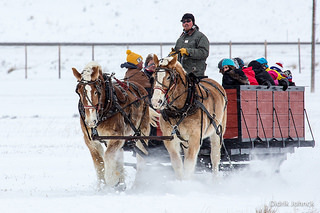
The sleigh ride is ideal for kids, including my six-year-old, Jasper, whose eyes are so wide he seems to be devouring the future. But it’s not the only family friendly thing to do in Jackson Hole….in fact, the county has transformed into an outdoor concourse for kids, another of the montropolian merits. Not long ago the valley, which even at its lowest point is over a mile high, was a cult destination for extreme skiing; not much of a family stop. But now the frozen assets include everything from bunny run skiing to tubing to snowshoeing, snowboarding, dogsledding, horseback riding, cross-country, snowmobiling, snowbiking, ice climbing, sledding, ice skating…there’s even a children’s museum. If ever you worry about the kids spending too much time in front of screens, this is the antidote to Angry Birds. Unplug, boot it down, let the screen be in the frame of the Tetons, and the glow come from the winter sun, and the challenges and glee come from Nature. Jackson Hole removes every excuse for staying in.
Another quality of the montropolis is a strong conservation ethos, and Jackson Hole is the birthplace of the modern conservation movement. Here they conserve soil, they conserve water, they conserve wildlife, they conserve open space, they conserve scenery.
It could be argued that the original Native Americans here embraced a conservation ethic as they revered these peaks that stretched their sky. There was a great spiritual connection. And the environment was so harsh and resources so limited it took a preservation stance to survive.
But the movement first found traction in 1897 when a Colonel S.B.M. Young, acting Superintendent of Yellowstone, proposed to expand Yellowstone’s boundaries southward to encompass portions of northern Jackson Hole and protect migrating elk herds.
John D. Rockefeller, Jr. stood beneath the gleaming silver blades of the Tetons in 1924 and was mightily impressed. The Yellowstone Superintendent at the time seized the opportunity to explain the hope of protecting and preserving “this sublime valley” from unsightly commercial development. Rockefeller decided to purchase offending private properties with the intention of donating them to the National Park.
It took more time than anticipated. The creation of Grand Teton National Park finally occurred on September 14, 1950, when Harry S. Truman signed the bill. Now, 97% of the land in Teton County is protected.
One synecdoche for the whole of the valley is the Teton Raptor Center. It started in 1997 when Roger Smith, a philosoraptor and wildlife biologist, started receiving calls to take in injured raptors. As he took in more birds, he expanded to rescue and rehabilitation, and then education and conservation. The center is now based in a set of old red barns at the base of Teton Pass in Wilson, and seems about to burst its seams with birds of prey.
Roger shows off eagles, kestrels, hawks and gyrfalcons, and then brings out Owly, a female great-horned owl, whom Roger rescued after she was hit by a car. She does her Linda Blair head swivel, locks her big eyes onto mine, and we exchange meaningful looks. We connect.
Roger thankfully breaks the moment “The real take-home message is that by knowing these birds we start understanding how things are connected. It’s easy to start putting the environment second fiddle if you don’t understand how things work.”
Afterwards I head over to the Mead Ranch where I meet up with Kate and her husband Brad Mead, whose great grandfather homesteaded here more than a century ago. In 2002, the family placed the ranch under conservation easement, ensuring that its pristine water, native pastures, open space and language-defying scenery would be protected forever. And now they raise the happiest cows in the world.
“For us, as a family, it’s really important that our cattle are treated right. They live a fantastic life out here. They hang out, look at the mountains, and don’t have to worry about much of anything. No feedlots; they roam free. We don’t give them growth hormones, steroids or antibiotics. We don’t feed them corn, just grass and recycled spent grains from the local brew pub. We treat them in a humane and respectful way. And they live quite a bit longer.”
I’ve worked up an appetite listening to Kate, so head over to the Q Roadhouse, and meet Matty Melehes, the chef, who sizzles with local goodness here. “We have a local band, local artists on the wall, a burger from the Mead Ranch, on a bun from a local bakery, using mustard made from a local beer, cheese from a local farm, and I’m from Jackson Hole, so I’m local as well.” Of course, I order a vegetable salad, but vegetables lack a sense of purpose when unaccompanied by a good cut of meat, so I call for the ranch burger as well, and it is, no denying, localicious.
The next couple days are devoted to the final quality needed to be proclaimed a montropolis: great snow motion. My visit happens to coincide with WinterFest, which is bookended on two weekends by Cutter Races and Ski-Joring. The former is a contest in which chariot-like vehicles are pulled by two horses a quarter mile down a snow-packed track. It’s also one of the biggest tailgate parties of the year, but all for a good cause. It’s sponsored by the Shriners, and the motto is, “The Cutters run so a child may walk.”
The other event, Ski-Joring, is a wild winter diversion in which a person on skis is pulled by a long rope attached to a racing horse through gates and over six-foot-high jumps down a 500-yard track. Not for the faint of heart, either to participate, or even watch. It’s no coincidence that the poster advertisers at the end of the run are “Teton Orthopedics” and “St. John’s Family Health and Urgent Care.”
But I’m here in Jackson Hole to partake, and begin with a cross-country ski run. I hook up with Jack Bellorado, who runs the Teton Pines Cross Country Ski Center, and together we head out to kick and glide some 10 miles of machine-groomed tracks beneath the fountains of the earth that are the Tetons. At one point we pass Olympic athlete Erich Wilbrecht, competitor in the 1992 Winter Games on the Biathlon team. He’s out for a little spin, at 60 miles an hour. “Once you’ve skied here, where else you gonna go?”
In the afternoon I catch up with Jess McMillen, the Freeskiing World Tour Champion, and the U.S. Freeskiing National Champion, and a keen champion for Jackson Hole, which she says is the best training grounds for freesking there is. She was born and raised here, but at 18 took off to check out the great cities and alpine villages of the world. Didn’t take long to return to the Golden Mean and plant roots. “I realized Jackson Hole has everything I’m looking for.”
We take the aerial tram up the Jackson Hole Mountain Resort, which boasts the longest continuous vertical rise of any ski resort in the country. “Every morning I wake up and look at the Grand Tetons and feel like I’m one of the luckiest people alive.”
It used to be that the skiing was famously black, on big terrain, but now they’ve re-designed so there are blue runs to the base at every major lift, making this a family friendly experience. Still, once at the top, Jess says “Let’s go ski some cowboy powder,” and rockets away, blond hair flying, and I’m left to enjoy the view and the blue. Can’t blame her. There are no friends on a perfect powder day.
For my final outing I team up with Mike Halpin, owner of Lost Creek Ranch Lodge & Spa, where the Modern Family cast stayed for one of their vacation episodes. Mike is a sled head, a snow machine buff, and claims that Jackson Hole has the best snowmobiling in the world. He offers to take me on one of his favorite runs, a ten-mile spin to Granite Hot Springs (we are, after all, adjacent to the most geo-thermally active terrain in the world.)
It’s snowing hard when we start out (in the winter Jackson Hole gets 42 days of snow…every month), but soon clears to ice blue skies as we whiz past dogsledders and scenery that chews it is so dramatic. After a couple hours riding through this supernal painting, our noses fill with the sharp perfume of sulfur. We park, and slip into a little rip in the earth’s crust that is the 104-degree hot springs, and soak away whatever residual blues came from beyond the blazing poetry of this place. At this moment it seems life beyond this valley is error. This is the place to be. This is montropolis.
##
The post The Fabled Montropolis Is Found: Jackson Hole appeared first on We Said Go Travel.
1974 in Nepal
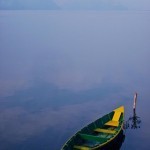
I spoke to my father above the roar of the Kathmandu streets, narrow and complex as veins. “There wasn’t a single car in Kathmandu when I was there,” he said, his voice light with disbelief. I told him about climbing to the top of one of the temples in Durbar Square, and a wiry boy running up and down the steps to deliver five rupee chai, boiled in a vast silver bowl atop a failing flame. I told him about the marigolds strewn across the square: prayer’s debris. But it was the traffic we spoke of the most, the sign of our distance and the years between us.
My parents lived in Nepal in the seventies, as part of a Southeast Asian odyssey. They were hippies who had previously been part of a commune on a small island off the coast of New Zealand, and this adventure was another way they affirmed themselves in the world.
My mother passed away when I was nineteen. When someone is gone, you do anything to draw them back into being. I had heard so many stories of my parents’ travels that I think I believed that I might actually find her there: lily-sinewed, young and blushing with adventure.
As I drove into the Nepali town of Pokhara on a rickety bus, clutching someone’s child in one arm and a baby goat in the other, while Justin Bieber’s Baby played over the sound system, I sought their house frantically. I knew that they had lived in a yellow shack, somewhere near the airport, and that was all. I didn’t find it, of course. I looked for my mother everywhere, but I didn’t find her.
Suddenly realized just how desperately I had been looking. I’m an inherent disbeliever: an atheist, a realist, a grudging voter. But when I called my father from Pokhara I was disheartened and confused about my journey. I thought I was going to find something to believe in. I found only a thicker fog of doubt.
I was twenty-four years old, female and alone in a country where so many people need or feel entitled to things from you. I had believed that I was brave. But I felt so small, and so wrong.
Mostly, I was lonely. Solo travel is not for the faint hearted, especially in the less developed parts of the world. No matter how many peaks I summited; no matter how many sunsets I watched, as golden and viscous as molasses, and no matter how many Facebook posts garnered hundreds of ‘likes,’ I was, essentially, alone.
I called my father from Pokhara I worked to keep the quaver from my voice. I think he heard it anyway. “Spin a few prayer wheels for me and your mum,” he said. “We walked those same streets all those years ago, in nineteen seventy four.” I didn’t know what to say. I said thank you.
That afternoon I wandered down into the town, and found a tiny bookstore, brimming with paperbacks. The one I chose was a battered copy of Kerouac’s On The Road.
As I left Pokhara and rode buses across Nepal and down into India, I clutched that book: an almanac of letting go. I read about people who did things just to know what it was like to do them. I scrawled in the margins about my own journey, and what the towering gods at the roadside had started to mean. I understood “the flush of homecoming joy in her face” in a way I never had before: I had left New Zealand, my home country, five years prior. I thought I would never return. I had run from the absence of my mother and the grief of my father for what I thought was forever.
But it was the literature, rather than the litany of my parents that made me believe in something again. Because everything changes: Kathmandu is thick with the vehicular roar of a people moving on. Their closeness was in their absence. It let me write my own adventure.
The next time I called my father, I told him that I loved him for the first time in years. Bravery doesn’t always mean wandering into a far away place. Sometimes it means looking back from that place, and seeing all you chose to be blind to.
“The road is life,” claims Kerouac. And the road is infinite. And I have stumbled. And I have been lapped by my own history.
But the most important thing Nepal taught me was to keep walking. Keep your suitcase packed and at the ready for that great and endless adventure: the arduous and worthy mountain peak that is your life.
About the author: Kirsti Whalen is a poet from in Auckland, New Zealand, by way of Melbourne, Australia and a few other places besides. Formerly a camel farmer, laughing yoga instructor and castle-dwelling au pair, she now studies creative writing at Manukau Institute of Technology, and works in disability advocacy and support.
Ready to go to Nepal? WSGT found these travel books and gear to help you prepare.
Lonely Planet Nepal: The best guidebook there is to Nepal
Trekking in Nepal: Nepal is the best place in the world to see amazing peaks!
Nepali Phrasebook: Learn a few phrases in the local language!
The post 1974 in Nepal appeared first on We Said Go Travel.
Recollections of an Old Farm in the USA

I remember once, while watching Elizabeth Gaskell’s North and South, how much Miss Margaret Hale loved her home, Helston. “It’s the best place on earth,” she says to Henry. I can say the same about my childhood home, where I grew up to my teenage years. It was not the sort of exquisite, well-built American home but rather a chunk of an old 40 acre vineyard. It was a rare treasure to me and probably more to my grandpa. Once he bought it, he cleared it of all the shriveled, twisted grape trees and branches and piled them next to the chicken coop. The top of it was as high as our storage barn. My cousins and I always jumped on the branches and beat each other to the top or sometimes outran each other from the pile when we heard rats squeaking underneath.
One afternoon, we were busy playing on the side of the long dirt road as my mom was getting ready to water her long bean field.
I tapped my cousin on the shoulder. “Wanna climb up and get some?” I pointed to the almond trees next to us.
“But they’re not ready…”she said, her face wringing in disgust.
“Come on!” I ran ahead and she obediently followed. We climbed up like monkeys and picked off a few. The almonds were still green and fury on the outside but I was still eager to try them. Turns out, unripe almonds weren’t so bad. It was hard to dig the seed out, but it was richer and fatter than the ripe ones.
My mom called us towards her so we climbed back down.
“Come here,” she said softly. “Do you want to swim?”
My cousin and I looked at each other in confusion.
“Swim where?”
“Here!” She grinned brilliantly and pointed to the small water canals.
“OK!”
We never swam in the plantation canals before so we took advantage of our first and last chance. When she opened up all the small, concrete pumps and water gushed out, we jumped in. It was perfect, even though the water was just to our knees. I loved squishing the mud underneath my feet and touching the cold water.
The only other real adventure we had was discovering a secret place. We usually don’t go all the way to the end of the long dirt road because it’s too far and sometimes creepy, but one time, we walked to the far east side. Out there was nothing but cord grass and cattails. Beyond that were miles of orange trees. We often heard noises from the big, dark trees and thought there were wild beasts hiding and looking at us.
At the very corner of the end of the road was an old, wooden shed. A large tree stood over it. Next to the tree was a tiny bathroom, like Shrek’s. It was the perfect hideout.
“Woooh…look at that,” I whispered.
It was the first time we’ve discovered something like it.
“Let’s go check it out.”
“No way, it’s too creepy! I’m scared,” my cousin said next to me.
She was right. The shed looked deadly ancient and haunted and the overcast from the tree made it even more terrifying. That meant adventure.
I slowly tiptoed towards the shed.
“Wait! Wait for me!” She crawled nervously behind me.
When I reached the door, I quietly pulled it open. It gave a loud, shrill cry. I expected something to suddenly pop out and scare my pants off of me, but I only found an old table, some chairs and a few pans. After we calmed down a bit, we explored around and finally decided to make it our shed. It became our secret place ever since.
These are only some of the memorable moments on that farm. Everyday there were places waiting to be explored and adventures waiting for us. It was the best place to grow up. To this day, I dream of returning to it. I want to feel the crisp air blow from the west, run down the long dirt road and watch the blossoms fall slowly from the almond trees and drink the juice of the ripened sugar canes. I want to swing from the high branches and fall into a massive pile of October leaves. I want to see the glorious sunrise explode above the thick orange trees and see the sunset on the eastern mountains nearby. What I want is to be a kid again. To play with imagination and possibilities. To pretend as if I owned the whole world and had nothing to think about but the new adventures waiting for me. I want to outplay the stress of an adult life. How little, then, did I know the dreariness of reality.
About the author: My name is Coua Lee and I currently reside in Minnesota. I am an undergraduate student at the University of Minnesota and will be earning my bachelor’s degree in English soon. Aside from my passion for writing and reading, I love art, music and sports. I find myself most comfortable outdoors and around my friends and family.
Thank you for reading and commenting. Please enter the Independence Travel Writing competition and tell your story.
The post Recollections of an Old Farm in the USA appeared first on We Said Go Travel.
July 20, 2014
#LiveAndDine2014 Angeleno Magazine
The summer day begins in Santa Monica!
Thank you @angelenomagazine for #liveanddine2014 @fairmontmiramar
In celebration of The Restaurant Issue, Angeleno magazine hosted its annual LIVE & DINE L.A. event, honoring the city’s most distinguished chefs and restaurateurs of 2014 who continue to shape and evolve L.A.’s culinary scene. Guests were treated to signature bites and menu samplings prepared by the celebrated chefs, which will be paired with exclusive wines and artisanal cocktails. Ticket proceeds to benefit Share our Strength.
This year’s restaurants include Acabar | Adoteca | Al Mare | Bestia | Cafe Rockenwager | CAST at Viceroy Santa Monica | The Church Key | Cliff’s Edge | Craig’s | Culina, Modern Italian | Faith & Flower | Fifty Seven | FIG Restaurant | Fishing with Dynamite | fundamental LA | Gracias Madre | Hamasaku |Justice | Malibu Pier Restaurant & Bar | Nest at WP24 | Nobu Malibu | The Polo Lounge | Rao’s Restaurant | SAAM at The Bazaar | Scarpetta | The Wallace | West Restaurant & Lounge | Wine Media Connect and more!
I met Chef Giacomo from Ristorante Al Mare on the Pier. I enjoyed: Caprese, polipo e patate, pannaciia e ciliegie Learn more at Restorante Al Mare @dinelamare
Next I tried the chicken sandwich on pretzel bread, and mini tropezienne from Rockenwagner. I am definitely going to show up for their $5 happy hour in Brentwood! I ate a sandwich recently at Whole Foods on their pretzel bread which is AMAZING!
The Kalamansi creamsicles from the Nest restaurant at the Marriott in LA LIVE were spectacular! They were made from limes from the #Philippines and were creative tasty creations!
Patrick, the General Manager of Rao’s Hollywood, told me that the roasted red peppers were a family recipe and that their New York City location started in 1896 is the oldest restaurant that has never moved! I cannot wait to go for a full meal!
Jason is a Free Diver and Fantastic Chef! I enjoyed his California Sea Bass and look forward to tasting all his tempting treats at @MalibuPier which is now just two months old!
Another Gorgeous #SantaMonica Sunday #sunset
Thanks to #liveanddine2014 and @angelenomagazine
This is my first instagram inspired Photo Essay! What do you think?
The post #LiveAndDine2014 Angeleno Magazine appeared first on We Said Go Travel.
Thailand: What Freedom Means in Solo Travel
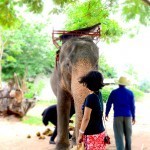
There are million ways to give a present to yourself after you graduate: shopping for anything you want, throwing a party, or travelling. I choose travelling. And since there are too many arrangements to make a group of best friends travelling together, I decide to travel alone.
The idea of a solo travel sounds liberating at first – a week in The Land of Smile, Thailand. It feels like I have an infinite freedom, but apparently, there are some constraints too, which I do not anticipate. Because in a new place where you neither speak the language nor have a tour guide, you practically count on yourself on how you have fun and stay safe at the same time.
Arriving in Surin, a town in the northern part of Thailand, I am greeted by the humid, cold air of a Monday morning street at a traditional market. My friend picks me up and we head to her in-campus apartment housing, five minute walk to where she teaches. Failing to get some sleep after 13 hours flight from O’Hare, Chicago – thank you, jet lag – I decide to walk out and see the surrounding area.
Later in the day, my friend brings me to an elephant village. It was one glorious memory where I make my first direct contact to the beautiful elephant. Back when I studied Southeast Asian Literature course, I read that elephants – particularly the white ones are heroes, a legend to the Thai and Vietnamese. They fought in wars and they represent great strength and purity.
In the real world, there is no white elephant. I was disappointed when my professor delivered the fact. But to be in the land, where I was only able to read the legend of it, I feel there is a magic when I touch the trunk and see the eyes of the graceful elephant. She responds by touching her tip of her trunk to my feet. She probably thinks I will feed her, but I have nothing in my hand.
I usually busy taking pictures, but I let myself enjoy the experience and interact with this friendly and calm female elephant. Wrinkles of her trunk and her watery eye look capture my attention. An elephant trainer asks me to sit on her trunk as the tall beautiful creature bends on her knees. A second later, she carries me up in the air. Wohooo!
A perfection defines my first day in Thailand. However, a happy beginning does not echo until the ending. That magic moment with the big beauty evaporates as I leave Surin.
Things in Bangkok go down to the worst as I find myself trapped in a tuk tuk, a motorbike with a carriage behind for tourists to sit.
I understand how I can be in that confusing situation. With a Thai-like face, people should be mistaken me as a local and therefore I will not get tricked. However, I walk with a map on my hands, which is a green alarm to some people who want to make profit – there, a tourist, go go go! So, instead of going on the right direction, I stop and correspond with a guy who looks like wanting to show me the direction to the Grand Palace. Big mistake. The guy leads me to that tuk tuk with an angry driver shouting “Welcome to Thailand!”. We go from one place to another, and on each place, another person welcomes with hospitality and a smile, touchy stories and then offers some purchase.
Yes, I freak out in my expressionless face.
Remember a scene in Home Alone movie where Kevin makes friend with an old scary women who feeds the pigeons? I think I am Kevin in that scene. Trying to take a rest after walking inside the super huge Grand Palace with splendid historical royal Thai belongings, a woman hands me a small plastic bag full with corn seeds to feed groups of birds hanging out freely in that area. I do feed the bird, and feel touched by the woman’s gesture.
Only after that, she said, “Ninety baht.” Ha! I leave her with 20 Baht and rush to get a cab.
By the end of the day, I am exhausted. Arrived at my Moroccan style hotel, my jetlag is totally cured by the adventure of that day. I manage to knock out myself to a deep sleep a second after I touch the bed. In my dream, I feel relieved that my day in Bangkok is over and that I am heading home.
This solo travelling has made me feel lost and insecure. But to me, I learn that this is the point of a solo travel – to be lost in your own freedom and to experience confusion in the middle of excitement.
About the Author: Emma Datu, M.A. in Southeast Asian Studies, fulfilled her dream to travel to Thailand upon her graduation from the University of Wisconsin – Madison. She currently teaches at Prasetiya Mulya Business School in Indonesia and enjoys teaching, cooking, and practicing yoga.
Thank you for reading and commenting. Please enter the Independence Travel Writing competition and tell your story.
The post Thailand: What Freedom Means in Solo Travel appeared first on We Said Go Travel.
Breathing in the Brave In the USA
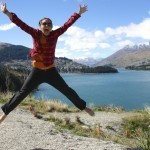
I walk down the path and I can breathe. Suddenly, I’ve risen above. I’ve risen above the traffic, the incessant rumble of rubber meeting pavement. I’ve risen above the strip malls filled with stuff that melts my brain into a mush of consumerism and more, more, more. I’ve risen above the clouds, and I’m at 7,000 feet taking a hike, skirting between California and Nevada. Sunrise red snow flowers spring up from piles of auburn pine needles, promising new life among the rubble.
Again I’m hiking at 7,000 feet and reaching my fingertips toward the clouds. There is supposed to be less oxygen the higher one climbs, but my lungs don’t feel strained; instead, they feel a sense of release, saturated with leafy nasal libations. This time around Piegan Pass is the goal with Glacier National Park as its backdrop. I keep my freak flag snuggly tucked in my back pocket, but pull it out on these occasions. Even though it’s mid-summer, snow patches still cover the ground up here, and glaciers remain hidden between mountain peeks (glaciers in Glacier, you don’t say). Instead of snubbing the frosty patch of ice like I normally would, I leap onto it and lie down to make a snow angel in July. The cold is welcome this time of year, and something in the air spurs me to action.
In New Zealand’s Arrowtown the sensation is multiplied. Everything is in high definition in this town and in this country as a whole: trees, mountains, trails. I look at my hands and feet and feel their connection to my body. Everything is working as one well-manufactured machine, but my soul skips like a little girl galloping through a field of lupine. A dozen trails take off from the Arrow River and I choose the Sawpit Gully Trail, which leads me up a hill peering over Arrowtown and Lake Hayes. I stop, equipped with my journal, and jot down a few thoughts. Then I grab my ankle and prop my foot on the inside of my calf in tree pose. I rotate through a series of spontaneous yoga poses, lifting my eyes to the sky and pointing my body toward the mountains in prayerful meditation. Time stands still as I focus on the air filling and emptying out of my diaphragm.
It doesn’t matter where I am in nature. As my boots meet the dirt, I feel free. I feel brave. I can “say what I want to say” as my husband and I walk and talk — about our dreams, about our next big adventure in Iceland and Norway, about the U.S. road trip we want to take next year. Heck, who knows? Maybe we’ll go work in Hawaii come January.
Out here, the possibilities are endless. I want to run and leap and boulder up rock walls. I want to be great and humble, calm and ecstatic, quick and slow. I want to be present in this moment and savor every crisp, full lung inhalation.
About the Author: Sarah Reijonen sold her house and 80 acres in eastern Washington to travel the world — that was five years ago. Since then, Sarah and her husband, Spanky, have traveled to nearly 30 countries and wander and work in California in their RV. Last year Sarah published her first book, a travel memoir entitled Country Girl: Letting Love and Wanderlust Take the Reins.
Thank you for reading and commenting. Please enter the Independence Travel Writing competition and tell your story.
The post Breathing in the Brave In the USA appeared first on We Said Go Travel.
July 19, 2014
Himalayan Footprints in Nepal
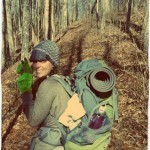
Himalayan Footprints in Nepal
It’s not often you find yourself voluntarily blinking to assure yourself that what you’re looking at is undoubtedly real. I can hear my eyes whisper, “I’m going to need some further substantial evidence to prove that this vista is genuine”. Nervously, I continued to survey the horizon, almost scared of the perfection. I had seen the Himalayas before, but never from the Everest Base Camp trail. As I stood there, atop of a grueling hill and hunched over from the heftiness of my pack, I noticed every occasion where the mixture of dirt and wind scraped my face. It’s almost as if the wind was bluntly stating to me, “Hey! This is life! It’s beautiful. Don’t ever forget that.”
Earlier that day one of my best friends and I left a quaint tea house after eyeing our imaginary watch and guessed that it was half past seven in the morning. We were heading northwest of Dingboche, which was a wonderful little town that should be the setting of a dusty Asian Western film. Graham (as in the cracker) and I grabbed our beloved hiking poles, stuffed one last can of half-eaten sour cream and onion Pringles in the mesh pocket of a backpack, and eagerly started our sixth day of hiking to the next village of Lobuche. As we settled into the routine of walking, I found myself noticing everything. I sink my gaze into the blackness of the crows as they fly in place in the wind. I observe the formation of rocks and I listen to Graham’s comment about the flies being from the prehistoric era and I make it my mission to take note of the biggest fly I can discover. The onset of a hike is always very peaceful for me; it’s my therapy. That is, until I get to the base of a hill and look up.
Our running joke was that we had to retrain our eyes on how far to look up. So as I stood, straining my neck to look up the rocky barrier that stood between me and the neighboring village, I could almost hear my crooked smile form as I loudly thought, “Game on”. I quickly forced myself to get in the zone. I began to notice every move and every breath I took. Patience becomes your best friend and mortal enemy in every step. I had an untied shoelace. I stared at it as I climbed, never stopping to tie it as it gave me something to look forward to doing once we stopped to rest. I have always loved the mountains because they have a way of stripping all your pride away. To me, summiting a mountain mimics the same feelings of love. The hike is hard, as is love, but you have to make yourself believe that it’s worth it. Your body is exhausted but you keep propelling upward in order to achieve that moment of elatedness. You can’t mimic the reward of standing on a peak or smiling at someone you love. You can’t fake happiness like that. So you put one foot after the other into a pile of dust, forget about the smell of the yak poop, push past the weight of the nearing sun, and keep pushing until your footprints exist at the top.
So there I was, slouching on a boulder at the crowning point of that bluff, sharing a comfortable silence and cherry flavored water with my best friend. Graham jokes, “Well….we have visually summited Everest so let’s go home now.” As I laughed, I settled into the moment, authorizing my brain to take it all in. I peered past the dust coated prayer flags and strained my eyes to look as far as I possibly could while I pondered perspectives that I usually wouldn’t approach. I thought, “There is so much pressure to want more; more money, better phones, cars with seat warmers. The older I become the less material things I desire. Enjoying the simple things in life, like perching myself on this cliff, allows me to be free! It’s these moments of freedom that change my perspective. It’s this brief encounter with the mountains of Nepal that push me to pursue my goals and dreams. This experience encourages me to be a better mother, a loving girlfriend, and a loyal friend. This freedom scatters its ashes on every aspect of my life and encourages me to find peace with myself even when I’m not breathing in the fumes of 17,000 feet.”
I’ve never envied people that leave this life with no scars….. so create your own opportunity. Strap on dirty hiking boots, get your palate prepared for milk tea, prepare yourself to walk to the left of prayer wheels, under pack, and just go. Go find your freedom.
About the Author: I am currently an overpaid bartender and a mother to a wonderful nine year old girl. I recently went back to school to “learn more stuff” and I spend my spare time thinking about what hill I want to climb next and deciding which passport stamp I find the most enjoyable to admire. Life is good.
Thank you for reading and commenting. Please enter the Independence Travel Writing competition and tell your story.
The post Himalayan Footprints in Nepal appeared first on We Said Go Travel.
Chasing the Sunset in India
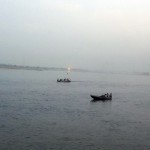
“Where the mind is without fear and the head is held high…” – Opening line of the famous Poem ‘Where the mind is without fear’ by Nobel Laureate Shri Rabindranath Tagore.
Since, the subject to highlight here is “A Place That Allows You to Feel Free”, I have to say that it is slightly difficult for me to name one such place and it will be highly unjustifiable to mother nature who has gifted us with such endless options.
I Can Catch the Sun (Or so I liked to believe)
My first destination as a solo traveler was Goa, where I volunteered at a Bed and Breakfast. I lived with a house full of people with different nationalities. Our day mainly used to be full of work until about 5:50 in the evening post which we used to run so fast to make it to the beach in next 7-10 minutes for the sunset as if running for life at the bull festival in Spain. I guess Independence is that 10 minutes run to chase the sunset. Independence for me was that half hour on the beach looking at the sun calling it a day.
Silence is Golden (At times it’s just a boat ride)
After spending 3 months in Goa, I returned home to Kolkata and then took a small weekend trip to sunder bans, the world’s largest mangrove. The entire trip was very much like I expected: boat ride, rendezvous with the local villagers, living inside of the forest, spotting wildlife, discovering a few hundred varieties of trees. But there were these couple of minutes during one of the rides where the captain of our boat shut off the engine and everything around us was so quiet that I could hear my heart beating… Quite literally. And I believe that was the only organ of my anatomy which was active because my mind wasn’t. At times, I still think if I could get that moment back where I could have the freedom of not being worried about what’s going on in my head and just hear my heart beating.
Better late than never
The holy city of Varanasi (a.k.a. Banaras a.k.a. Kashi) is known to be the favorite city of Lord Shiva. It is also said in Hindu Shastra, dying in Varanasi brings salvation to the human soul. Upon my boat ride (I have a thing for boat rides) from Assi ghat to Dashaswamedha ghat, to see the sunrise (I have a thing for sun rise/set too!); I witnessed a corpse covered with white cloth and adorned with garlands floating on the river surface. And, immediately after that view I spaced out of the rest of the boat ride to the world of my imagination – the world where I would travel to a million places, see a mother deliver a child, witness a miracle, change someone’s life for better, and a thousand other things. But, I have to do it all before my dear life is no more mine.
Recently, I wrote about the importance of having a dream and living it. And, I guess independence is related to the same. For people who find joy in travelling the world, freedom is to be able to travel to the far ends and explore places unknown to them. There are times during most of our travels that we hit that space where we are free from everything worldly and are overjoyed by consuming what our surroundings have to offer. Near or far, long or short, no matter what sort of a journey you are in, make sure to keep moving if that’s your idea of independence because otherwise, you are just going to bound yourself to a life which you don’t desire.
About the Author: Aditi Roy is a Journalism and Mass Communication Graduate, who is originally from New Delhi, India but now lives in Kolkata with her family. She quit her permanent job in 2013 to chase her dreams and travel the world. She now works as a Freelance Writer and maintains her travel blog on WordPress. On her free time, you can either find her reading other travel blogs or picking after her mother!
Thank you for reading and commenting. Please enter the Independence Travel Writing competition and tell your story.
Ready to tackle India? WSGT found these travel books and gear to help you prepare.
Lonely Planet India: The Best travel guidebook there is to India
Language Phrasebook: Not everyone in India speaks English. Learn a few phrases in the regional dialect, including Hindi, Urdu and Bengali!
Lonely Planet Hiking the Indian Himalaya: Want to see the highest peaks in the world? Here is your guide!
The post Chasing the Sunset in India appeared first on We Said Go Travel.
We Said Go Travel
We Said Go Travel is a global community of over sixteen hundred writers with articles from every continent.
Stories are shared with photos and video from a perspective of the transformative power of travel. We Said Go Travel has hosted live and online events as well as travel writing contests around the world. ...more
- Lisa Niver's profile
- 57 followers


